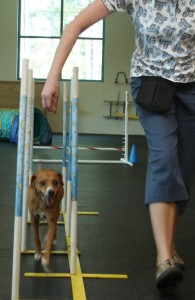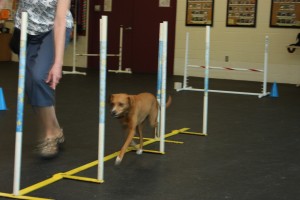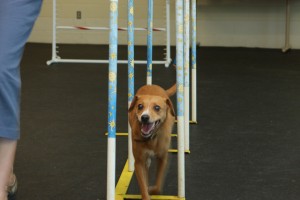
One of the agility obstacles that Grace and I have not spent a lot of time with is the weave poles. When first learning this particular skill, the poles are “open” to create a channel that the dog walks through. Eventually, the goal is to have poles “closed” or set in a straight line so the dog then weaves around each pole in a zig-zag pattern. The most advanced dog will fly through as fast as they can – speed is required for winning agility dogs.
At a recent class, Grace did really well with these poles—considering how little we’ve worked with them. She readily goes in but she sometimes veers off in the middle or enters after the second pole instead of the first. There is also a standard for how you enter the poles and even I can’t remember if it’s right or left, so I’m fairly confident that Grace doesn’t remember that yet, either. We both have some learning to do.
The thing that amazes me about agility – and I believe it’s true about so many things—is how simple it can look on the surface but how complex it is to truly master it. Agility can provide a fun and non-competitive activity that has benefits of exercise along with mental stimulation. Yet it provides the opportunity for mastery of a complex craft; there is so much to know about the nuances of every move, yours and the dog. I’m starting to realize that it can take years to develop sufficient knowledge and efficient skills that encompass every single movement of your hand, the words you use, and the placement of your body. All of it (and most likely much more) determines the dog’s ability to perform.

In business, it seems we often don’t create this structured learning cycle. Because people have full plates and it is difficult to devote adequate time to training, employees are expected to perform at the highest level, immediately. Some managers provide the environment for risk-taking and mistakes, many do not. On-the-job training is valuable, but should be supported by strong mentoring and knowledgeable resources. If the learning process is rushed, incomplete or random, it can create so many issues, potentially ending in failure or blemishes on a person’s self-esteem.

When Grace goes through the weave poles right now, she thinks she’s a champion. She doesn’t even realize that we’ve only just begun. With each opportunity to build her confidence, we move to the next level. In agility, our instructor, Rachel works to make sure that the last experience for each dog on each piece of equipment is a positive one, so that they are excited to return for more. We need to stretch our physical and mental muscles, but we must also rest them, too, for the best learning.
